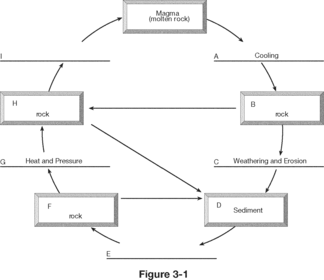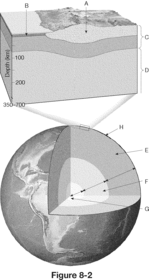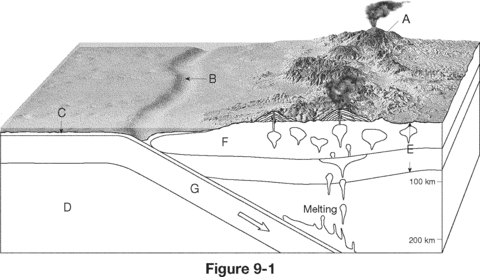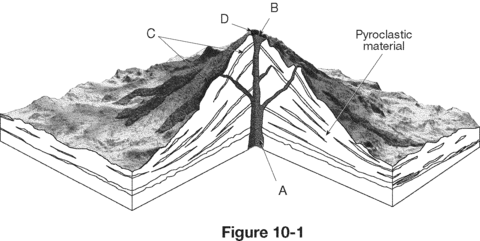Covers Earthquakes Volcanoes Plate Tectonics and the Rock Cycle
Pin adicionado em
1263
0
0
|
|
Criado por Brian Hedspeth
quase 10 anos atrás
|
|
Fechar
|
|
Criado por Brian Hedspeth
quase 10 anos atrás
|
|

A fault is ____.
the place on the surface directly above the focus of an Earthquake
When an earthquake occurs, energy radiates in all directions from its source, which is called the ____.
Force that causes earthquakes
Which seismic waves travel most rapidly?
P-waves can travel only through
Which seismic waves compress and expand rocks in the direction the waves travel?
which seismic waves are the most destructive?
A travel-time graph can be used to find the ____.
The distance between a seismic station and the earthquake epicenter is determined from the ____.
The scale most widely used by scientists for measuring earthquakes is the ____.
What instrument records earthquake waves?
The trace that records an earthquake from seismic instruments is called a ____.
what are the three types of rock?
rocks are classified by ____.
what type of rock should occur in the part of the rock cycle labeled B?

what process or processes would be occurring in the part of the rock cycle labeled E?

In Figure 3-1, what type of rock should occur in the part of the rock cycle labeled F?

A rock that forms when magma hardens beneath Earth’s surface is called an ____.
A rock that forms from cooling lava is classified as an ____.
As the rate of cooling of igneous rocks increases, the size of the crystals that form ____.
What is the correct order of the processes involved in sedimentary rock
formation?
What type of sedimentary rock is formed from weathered particles of rocks and minerals?
Most of the heat for contact metamorphism is supplied by ____.
Which are the three agents of metamorphism?
A foliated metamorphic rock forms when crystals ____.
A fault is ____.
the place on the surface directly above the focus of an earthquake
the actual source of an earthquake
Which seismic waves travel most rapidly?
Which seismic waves compress and expand rocks in the direction the waves travel?
Overall, which seismic waves are the most destructive?
What is the minimum number of seismic stations that is needed to determine the location of an
earthquake’s epicenter?
The amount of shaking produced by an earthquake at a given location is called the ____.
The Richter magnitude of an earthquake is determined from the ____.
A succession of ocean waves set in motion by a submarine earthquake is called a(n) ____.
What layers of Earth make up the lithosphere?
What layer of Earth is labeled C in Figure 8-2?

What layer of Earth is labeled E in Figure 8-2?

What layer of Earth is labeled B in Figure 8-2?

Earth’s thin, rocky outer layer is its ____.
boundary between the crust and the mantle
Through which Earth layer are S waves NOT transmitted?
Wegener’s continental drift hypothesis stated that all the continents once joined together to
form!____.
The supercontinent in the continental drift hypothesis was called ____.
According to the theory of plate tectonics, ____.
In the plate tectonics theory, the lithosphere is divided into ____.
What kind of plate boundary occurs where two plates grind past each other without destroying or
producing lithosphere?
Which of the following results when divergence occurs between two oceanic plates?
What feature is labeled B in Figure 9-1?

What layer of Earth is labeled C in Figure 9-1?

What process is illustrated by the area labeled G in Figure 9-1?

The Hawaiian Islands were formed when the Pacific Plate moved over ____.
The thermal convection that drives plate motion is caused by ____.
A magma’s viscosity is directly related to its ____.
What factors helps determine whether a volcanic eruption will be violent or
relatively quiet?
As the temperature of lava increases,its viscosity ____.
Highly explosive volcanoes tend to have what type of magma?
A volcanic bomb is a ____.
The particles produced in volcanic eruptions are called ____.
Large particles of hardened lava ejected from a volcano are called ____.
What is the most abundant gas associated with volcanic activity?
What type of volcano is built almost entirely from ejected lava fragments?
The broad, slightly dome-shaped volcanoes of Hawaii are ____.
A volcano that is fairly symmetrical and has both layers of lava and pyroclastic deposits is a ____.
What feature is labeled D in Figure 10-1?

What feature is labeled A in Figure 10-1?

What type of volcano is illustrated in Figure 10-1?

The most violent volcanic eruptions are associated with what type of volcano?
A caldera is a ____.
The volcanic landform that is formed when the more resistant volcanic pipe remains after most of the
cone has been eroded is called a ____.
Structures that form from the cooling and hardening of magma beneath Earth’s surface are ____.
The largest intrusive igneous body is called a ____.
Which type of intrusive feature forms when magma is injected into fractures cutting across
preexisting rock layers?
A lens-shaped intrusive igneous mass close to Earth’s surface is called a ____.
What commonly horizontal intrusive igneous body is formed when magma is injected parallel to
sedimentary bedding planes?
Magma forms when solid rock in the crust and upper mantle ____.
Magma tends to rise towards Earth’s surface primarily because ____.
Most of the active volcanoes on Earth are located in a belt known as the ____.

 Ocultar acertos
Ocultar acertos